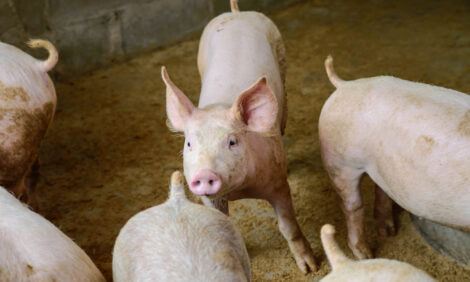



Weekly Purcell Report
US - Agricultural US Commodity Market Report by Wayne D. Purcell, Agricultural and Applied Economics, Virginia Tech. Weekly Purcell
Agricultural Commodity Market Report Wayne D. Purcell Agricultural and Applied Economics Virginia Tech |
LEAN HOGS on the CME were mixed on Monday, with nearby months lower pressured by their premium to cash prices, traders said. The APR’06LH futures closed down $0.375/cwt at $53.85/cwt with the JUNE’06LH contract sinking $0.175/cwt to $64.625/cwt. The April lean hogs contract expired at12:00 p.m., CDT. One trader is quoted as saying, “Nobody knows what to do. The premium is too big, but the cash is going to go up.” Cash hogs at Midwest markets were mostly higher on Monday amid increasing pork carcass cutouts from last Friday and a fairly active pork trade last week. The composite pork cutout value for Friday was up $0.30/cwt at $59.73/cwt. Hog slaughter was light on Monday due to some pork plants being down for the Easter holiday.
USDA placed Monday’s kill at 288,000 head, versus 337,000 head a week ago and 383,000 head a year ago. Cash hogs in the Iowa/Minnesota markets averaged $53.18/cwt on Monday. Weighing on futures prices were hog slaughter numbers and hog weights trending somewhat higher than analyst expectations. Asked after the fact, some analysts stated, “All this just means that more pork is coming.” Deferred hog contracts did move higher on ideas cash markets will do the same into the summer grilling season. Also pressuring prices were the latest CME lean hog index of $53.35/cwt.
This was off $0.24/cwt, compared with April futures at $53.85/cwt and June at $64.625/cwt. As export demand remains strong for U.S. pork amid expectations of better pork and beef movement as the grilling season begins, the meat market remains burdened by extremely large supplies. Even though bearish trends are still in place, last week’s mid-week activity shows some support. Hedgers should have exited all short positions last week. Cash sellers should keep sales as current as possible. Sell-stop orders in the MAY’06LH futures at the $63.00/cwt and the JUNE’06LH contract at $63.50/cwt levels could be considered to take advantage of any downside slip protecting 2nd quarter marketings.
CORN on the CBOT opened 4.2¢/bu to 4.8¢/bu higher but came off those opening highs as trading slowed from the active pace seen in early trading. The market is seen as adding back some premiums after last week’s correction. The MAY’06 corn contract was up 4.4¢/bu to $2.406/bu before finishing the day at $2.362/bu, up 0.2¢/bu for the day. The DEC’06 contract opened 4.8¢/bu higher establishing its session high at $2.732/bu before falling back to close at $2.692/bu, up 0.6¢/bu. The market rose higher from effects of concerns about rain-delayed U.S. corn plantings, a gold market surging to 25-year highs, and a volatile crude market.
Traders are expecting the USDA’s weekly crop report to show U.S. corn plantings at 14% - 17% complete. Rain delayed some plantings over the weekend in the U.S. Midwest but only minor delays were expected in South America due to rain. Funds bought 4,000 contracts (20 million bushels) by midday, floor sources said. Weak export numbers and sharp losses in Wheat took some steam out of the market. USDA reported weekly export inspections at 29.2 million bushels, down from estimates of 32-37 million bushels. Cash basis bids for corn in the Midwest early Monday were mostly steady as farmers slowed sales looking for higher cash corn. Friday’s CFTC Commitment of Traders report showed funds expanding their net long positions in CBOT corn for the week ended April 11. Technical support in MAY’06 corn futures was placed at $2.354/bu and resistance at $2.407/bu. Primary support for DEC’06 futures is placed at $2.654/bu with secondary support at $2.678/bu. Almost anything still may happen as rain slows planting progress of new crop corn amid forecasts of drought possibilities. Early season production forecasts mixed with dire weather forecasts make for volatile markets.
Even though planting intentions show lower-than-expected one must remember that current estimates have about a 20% chance of being accurate. U.S. corn production may range from 9.940 billion bushels to 11.6 billion bushels. The low side of ending stocks could drop to just over 500 million bushels with an average farm price of over $3.00/bu! If upper production possibilities are correct, ending stocks would pass 2 billion bushels taking the average U.S. corn price below $2.00/bu. The true nature of corn acres planted is usually not known until late July. For the corn producer who has followed advice to date production costs should now be covered and a profitable year should be on the horizon. Two weeks ago when corn was at $2.66/bu it was advised that cash sellers sit tight on new crop corn priced at the 25%-50% level. Since Corn at $2.73/bu has only been available 9 years of the last 20 years and is now hovering in the $2.69/bu - $2.70 range, cash sellers may consider advancing sales to at least the 40% level.
Hedgers who had 50% of the crop hedged should have come off at least 25% of those positions last week. You may want to consider keeping at least 25% of the crop at that level with sell stop orders for another 25% of the new crop 10¢/bu below current price in case the market moves higher. If the market goes lower those sell-stop orders will be filled.
SOYBEANS futures at the Chicago Board of Trade (CBOT) finished well on Monday with the MAY’06 and NOV’06 soybean futures both up 8.4¢/bu and 8.2¢/bu respectively. The MAY’06 soybean contract closed at $5.714/bu and the NOV’06 futures closed at $6.044/bu. November beans climbed back above $6.00/bu for the first time since April 3. As with the corn market, soaring gold and crude oil markets along with concerns about wet weather hampering field work supported prices.
Funds bought 6,000 contracts (30 million bushels) noting short covering, according to floor sources. USDA reported weekly export inspections within range-of-trade estimates for 10-15 million bushels at 11.5 million bushels. Higher prices were seen as keeping Asian soy buyers away from the market amid quiet weekend exports. Soybean crush was placed at 152.9 million bushels, above the average trade estimate of 140.8 million bushels. Cash bids for soybeans had a firm tone in the U.S. Midwest and the Mid-Atlantic states reflecting demand from elevators and exporters amid slow farmer sales. Friday’s CFTC Commitments of Traders report showed large speculators expanding their net short positions in CBOT soybean futures for the week ended April 11.
Two weeks ago this report reminded cash sellers that the ’05 bean crop should have been long since sold by now. Cash sellers not forward priced at 50% of the 2006 crop should consider getting there taking advantage of any of these price rebounds. Hedgers should have taken some profits on about half of the 50% crop coverage week before last. It would be considered prudent to remain at the 25% level of the ’06 crop. If options are a consideration look at two put options vs. one call option for some protection against price breakout.
WHEAT in Chicago for both MAY’06 and JULY’06 CBOT wheat futures closed down 8¢/bu– 8.6¢/bu at $3.494/bu and $3.624/bu respectively. Markets declined on news of rain in dry portions of the HRW belt in the U.S. Plains. The Kansas City (KCBT) market led the way in declines with JULY’06 KCBT wheat futures closing at $4.430/bu, down 21.4¢/bu. Profit taking after recent advances also weighed on prices. Traders expected the weekly USDA crop ratings late Monday to show a decline in U.S. winter wheat ratings. Funds sold 2,000 contracts (10 million bushels) unwinding KCBT/CBOT spreads, according to floor sources. USDA reported weekly export inspections of U.S. wheat at 9.5 million bushels, below trade estimates of 15-20 million bushels.
Friday’s CFTC Commitments of Traders report showed large speculators adding to net long positions in CBOT wheat combined futures and options for the week ended April 11. Funds trimmed their net short positions in CBOT wheat only. The 14-day RSI for the JULY’06 CBOT contract is placed at 54.38 so there is more room for buying. An RSI of 70 is said to be oversold. On Monday, the JULY’06 contract showed bearish opportunity as the 14-day RSI turned down along with the 4-day moving average as it diverged from an upward trend in the 10 and 20-day moving averages.
On 4/11/06, the trading gap set on 3/14/06 was filled before price turned lower showing opportunity for short positions. Primary and secondary support on JULY’06 CBOT wheat futures are set at $3.531/bu and $3.56/bu respectively. Cash sellers should consider pricing up to 40%-50% of the ’06 crop if they are not at those levels already. Hedgers should not have any short positions in place at this time but be prepared with 10% incremental buy-stop orders in the $3.58-$3.60/bu range and then the $3.55-$3.57/bu range.









